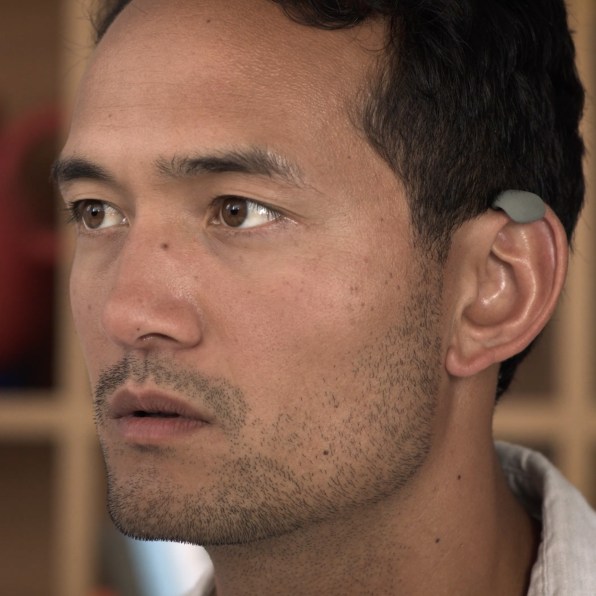- | 9:45 am
What a brain-controlled computer might feel like
A series of videos demonstrates an imperfect but optimistic future where we control everything with our brains.

Imagine if you could control your iPhone with your mind. How would that actually work? Would sad emotions automatically pull up cute animal YouTube clips? Would you use your brain as a cursor to hit buttons? Would you type text messages by thinking words . . . and if so, how do you stop from thinking words *BUTTS* that you didn’t *ARMPITS* actually want to send?
These are the questions both asked and answered in a new series of concept videos imagining a day in the life of having a brain-computer interface (BCI). We are on the precipice of computer chips being able to read sizable pieces of human thought while companies like Meta and Snap have funded research in this industry estimated to reach $3.3 billion by 2026. Just as designers needed to invent modalities like pinch-to-zoom to make touchscreen smartphones feasible, so too will they need to create new interfaces for us to focus our jumbled thoughts into organized bits.
The concepts seen here were created by Card79, a Bay Area design firm that previously helped design both an earlobe wearable and a surgical robot for Elon Musk’s BCI company Neuralink. “I remember being in a meeting [at Neuralink],” recalls Afshin Mehin, founder of Card79. “They had three drill bits in the room, and they asked, ‘What size drill bit would you be willing to drill into your head?’ I said . . . ‘None of them? . . . Maybe that one?’ [But] the more and more we see this stuff, the more it normalizes it. Just being exposed to it, I think we’re subconsciously becoming more familiar with what this could do.”

[Image: Card79]
Which is to say: Mehin is excited about the future of BCI but also reasonably skittish—and that comes through in the films Card79 created as its own spec project. Many future concept videos present a utopia, a world in which everything just works thanks to a magical new technology. This series of videos isn’t like that at all. They imagine what would happen in the year 2022 if an over-the-ear brain-reading device actually came to market. They feel more akin to watching an early adopter struggle with a new smartphone than some Hollywood sci-fi film where we all have cords running from our brains.

[Image: Card79]
In the main video embedded here, the protagonist is getting used to his new brain-reading gadget, which acts kind of like Siri or Alexa, just inside his mind. At times, it offers him superpowers. Just with his thoughts, he can ask his computer to remember an inspiring passage he read last night. And when he sits down to work, he generates a 3D model in mere seconds by thinking every button and adjustment he wants to use next in a rapid-fire editing sequence. But in another moment, his phone starts sending his brain notifications, and instead of just flooding his screen, they flood his mind like a wave of advertisements that he cannot mute (until he mentally shouts for them to be silenced). The video makes it clear that, for brain interfaces to actually arrive, we need far better consumer standards than what we’re accustomed to today with our phones.

[Image: Card79]
Most of the interfaces in the video are the same as any other spoken interface, just in your head. That comes from real research examining the capabilities of BCI systems. Researchers are beginning to read the words people say in their heads, even if what we consider thought is so much richer than our inner monologue.What if we don’t want to talk? Another rich modality within BCI could be thinking kinesthetically, and actually imagining physical movements that the computer can read. Of course, training your brain to communicate through imagined physical actions is, pardon the pun, a heady idea. So Card79 imagines an accompanying app that would have you picture your hand drawing letters of the alphabet. This idea is also based upon active research.
In some of their more future-forward concepts, Card79 imagines that kinesthetics could be a two-way street, allowing someone to download a new handwriting font or the choreography needed to wrap a gift perfectly—and then instantly have that new skill beamed via their brain to their hands. The logic is reminiscent of how the character Neo learned kung fu in The Matrix. But without all the shiny leather and sunglasses, the possibility seems far more practical (and mundane).

[Image: Card79]
In yet another video, Card79 asks the big question: How do you keep your thoughts private when messaging someone else? When told to keep a wedding announcement secret, our protagonist decides to save that information in a locked folder. And so when a curious friend fishes about the engagement later, a pop-up notification appears on the protagonist’s screen warning him to keep the secret—but also offering him the option to share it anyway.Of course, that sounds pretty overwhelming to me—as if a computer is suddenly standing in the way of every thought and impulse I have. Mehin isn’t pretending that his firm has figured out how BCI should work; he just believes these provocations will start necessary conversations so that, if and when we do develop mature mind-reading technology, design is in place to protect us and maintain our joy, rationality, and sense of self.
“It’s always dangerous to go on this path because the real opportunity where people are benefiting are patients with full-bodied paralysis. It’s going to potentially shift their entire lifestyle,” says Mehin. “Encouraging this work and fostering it for that population is super important, but it’s hard to tell where all this stuff is going to go [next].”




































